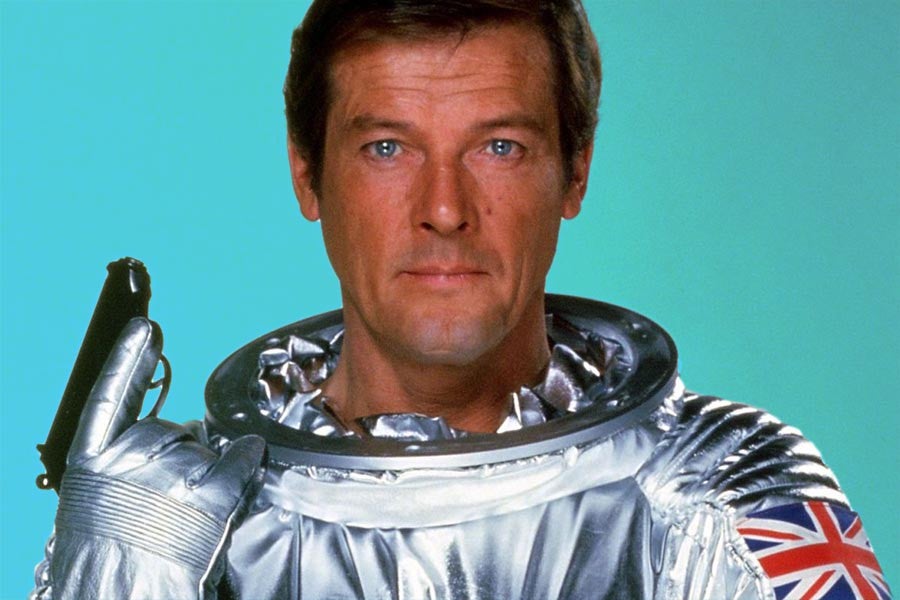For more than a decade now, viewers have had one vision of James Bond — that of a lethal, tormented assassin haunted by a fucked-up childhood and the death of his one true love, Vesper Lynd (played by Eva Green in 2006’s Casino Royale). But that’s a relatively recent image of 007. Roger Moore, the man most responsible for its polar opposite — a swingin’, dapper James Bond who saves the world while treating his do-or-die missions like a wry joke — has just died.
Before he was Bond, Moore was a popular actor, best known as the star of the 1960s TV series The Saint, which was the perfect training ground to take on Ian Fleming’s superspy. In The Saint, he was a globetrotting, womanizing thief who, in Robin Hood fashion, only targeted criminals. Funny, exciting and glamorous, The Saint segued seamlessly into Moore’s first Bond outing, 1973’s Live and Let Die. Moore had been approached about playing 007 during The Saint, but he couldn’t get out of his contract. But when it came time to finally take on the role, he worried how he was going to compete with the legacy created by Sean Connery.
“There is always a huge challenge associated with taking over a role from another actor, particularly when he has enjoyed great success in said role,” Moore wrote in Bond on Bond: The Ultimate Book on 50 Years of Bond Movies. “I knew I’d face comparisons and wondered if I’d even be accepted by audiences.” So he tried to find his own way into the character. “[H]aving known many soldiers and servicemen, I didn’t necessarily believe that Bond was a man who enjoyed killing,” Moore recalled in Bond on Bond. “He’d have to be rather sadistic to get a kick out of it. In fact, when I reread the Fleming novels there was a line that stated, ‘Bond did not particularly enjoy killing.’ And that was the key to my interpretation of the role: I wouldn’t enjoy killing, but I’d do it professionally, quickly and accurately.”
A de-emphasis on the franchise’s relatively gritty life-or-death stakes was the first of two major twists Moore brought to the Bond legacy. The second was the character’s love of pleasure. “Fleming made it clear Bond enjoyed the finer things in life—from food, drink, cars and travel to, ahem, women,” Moore noted. “That’s not a bad job description, is it?”
It certainly looked like Moore was having a good time. From Live and Let Die through 1985’s A View to a Kill — a longer timespan than even Connery inhabited the role — the 007 we saw on screen wanted you to know that his life was amazing. If Connery’s Bond had been a tall, dark, handsome killer — rugged and virile with a wit as dry as his martini — Moore’s seemed to be winking at the camera.
And let’s face it: The whole notion of an indestructible British agent traipsing around the planet sleeping with beautiful women and defeating criminal masterminds is a completely ridiculous concept. Connery’s unflappable cool made you buy the conceit; Moore, on the other hand, leaned in to the joke, always supplying a bit of a smirk to the dashing hero.
This attitude, of course, didn’t play well with hardcore Bond fans. Reviewing A View to a Kill, film critic Gene Siskel complained, “I keep coming back to this: Roger Moore, for me, has never worked as James Bond. Never will — it’s Sean Connery’s act. A rule in show business: Don’t do somebody else’s act. He doesn’t take the film seriously. If he isn’t seriously scared — if he has this light comic approach, that’s what he always says in interviews — well, I say then we don’t feel in jeopardy for him.”
By the end of Moore’s run as 007, the franchise had become a pale, hammy, cartoonish shadow of its former self. (And Moore was close to 60 when he stepped away after A View to a Kill.) In subsequent years, the producers would try to reconceive the character, tapping Timothy Dalton for a more serious, workmanlike Bond. After two installments, he was gone, replaced by Pierce Brosnan, who brought back the smirk that Moore had first given the character. It was only with Daniel Craig and the recent string of Bond films that the franchise has embraced the spy’s inner darkness. When critics praised recent movies like Casino Royale and Skyfall for their more realistic, grown-up portrait of Bond, what they’re essentially saying is that they prefer this Bond to the jokester version Moore gave the world.
But let’s be fair: Moore’s Bond was perfect for its time, when Hollywood was in the business of producing light, escapist event movies. His era was the same one as Star Wars and Superman: Big, happy movies that attracted as wide an audience as possible.
In recent years as studios have embraced Dark Knight-style somber reboots of beloved properties — and the Jason Bourne movies upped the stakes when it comes to hard-hitting spy films — the sober Craig version of Bond was inevitable. It’s impossible to imagine something like Moonraker (a.k.a. James Bond in Space) or the super-dopey opening of Octopussy (in which Bond goes undercover as a clown) being permitted in today’s blockbuster environment.
And it’s not that all Moore’s Bond movies are bad. As campy as it sometimes is, 1977’s The Spy Who Loved Me is proof of the supremely confident 007 that Moore could be, dispatching bad guys and sleeping with every gorgeous woman he can find with an unflustered nonchalance.
In our modern blockbuster world, where superhero characters are constantly riddled with emotional distress and tortured backstories, there is something eternally comforting about Moore’s joyful silliness as 007. His vision of a fun-lovin’, libidinous scoundrel is a relic of a less enlightened time. But as Moore understood, sometimes we all need a little ham in our cinematic diet.

